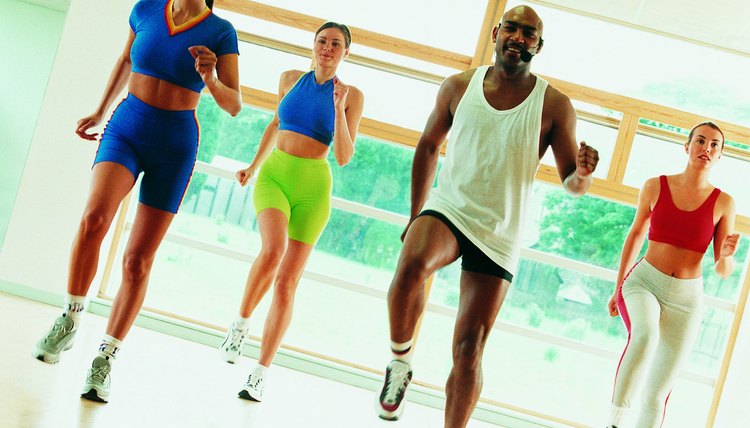Five Physical Components of Aerobics

Aerobic exercise encompasses five important components that play a role in your physical fitness. While some components, such as the warmup or cool-down, help your body adjust to and from activity, factors such as intensity and frequency dictate the benefits you get from physical activity. Incorporating each component reduces injury and keeps your body in prime condition.
Warmup
The warm-up component of aerobics primes your body for ensuing activity. As you do low to moderate levels of activity to prepare for aerobic exercise, your body becomes accustomed to a higher level of strain. Human Kinetics proposes slow walking or jogging as a warm-up activity. The duration and type of warmup you do is contingent upon the intensity of your conditioning phase in aerobic workouts.
Endurance Conditioning
Endurance conditioning is your prime focus in aerobic exercise. For instance, if you plan on running, then running would constitute this phase. In endurance conditioning, you are placing the most strain on your body. You create the gains and benefits associated with aerobic activity. This phase is guided by intensity, frequency and duration of your exercise.
Frequency
The frequency component of aerobics refers to how often you workout during a week. According to Human Kinetics, the recommended frequency of aerobic exercise is three to five days a week, though two days a week is still beneficial. How often you exercise is informed by the intensity of your exercise -- moderate activity such as jogging may dictate more days within a week, while intense activity such as running warrants less days during a week. Combining levels of intensity within a week can maintain your activity level while giving your body rest on low to moderate intensity days.
Intensity
Intensity in aerobic exercise indicates how much strain you put on your body. Increased heart rate is a natural reaction to increased activity and is also a measure of your workout intensity. Calculate your maximum heart rate by multiplying your age by 0.67 and subtract the number from 206.9. Your maximum heart rate is the limit at which your heart can beat during activity. Use this number along with your activity factor, which is based on your current fitness level, to find your heart rate. Your activity factor is one of the following: 0.60 if you do not exercise, 0.65 if you rarely exercise, 0.75 if your exercise sporadically, 0.85 if you do moderate to vigorous activity, and 0.95 if you typically do high intensity exercise.
Cool Down
Like the warm-up component, the cool-down helps the body adjust to a changing level of activity. Instead of priming your body for activity, you prime your body for rest. The cool-down period is essential for helping your heart reach its resting rate. Foregoing this component can lead to a drastic and unsafe drop in blood pressure. Cool-down activities can be the same as warmup -- walking is an appropriate way to cool down from running or jogging. Stretching also works as a cool-down activity and can lend to flexibility.
References
Writer Bio
S. Grey has a Master of Science in counseling psychology from the University of Central Arkansas. He is also pursuing a PhD and has a love for psychology, comic books and social justice. He has been published in a text on social psychology and regularly presents research at regional psychology conferences.
